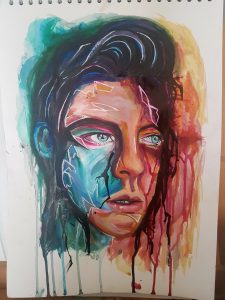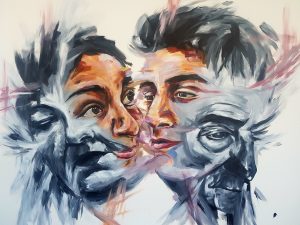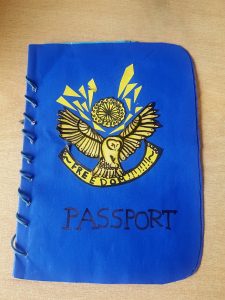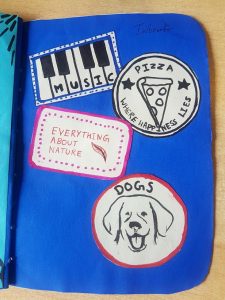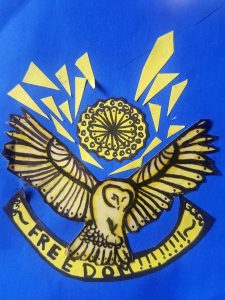Throughout my years of practice, I typically create paint on canvas that are relatively average, not too big or too small. Also, despite the fact that I discuss and borrow ideas from other artists, I tend to physically work alone in a secluded space. Although I enjoy my solitude, I would like to radically increase the size of the surface I work on; perhaps the canvas could stretch across the whole room and coil itself around the ceiling or walls. As well as the size, I’d like to invite a range of artists to colour the blank canvas with their personal style of art thus creating a large collaborative artwork. It’d be fascinating to see contrasting artworks blend into one entity sharing one body; realistic portraits painted amid landscape inspired by cubism or the canvas could be embedded into an installation/ sculpture. The paintings could be animated by projecting a film on the canvas. This supersized project is a chance for artists to play and experiment; it’s a safe space that allows artists to create spontaneously without stressing about judgement.
Author Archives: Pratigya Rai
Task 11
The blog has enabled me to learn and accept a multitude of information in many ways; the information that I was required to research were unconventional to me, it allowed me to broaden my understanding of the transformative nature of art. My reflection of the exhibitions that I’ve visited made me truly acknowledge the art, it made me appreciate its craft and reflect upon the significance of context. For instance, upon researching Mark Bradford, I understood that the materials used can have the equal significance as the body of the art, both can be manipulated to create art that immerse and tell a story of its origin. Additionally, my fears of authorship, originality and appropriation was subsided as I gradually began to understand these concepts. I was informed about an artists’ entitlement and the legality of copying someone’s art. This process of self-reflection helped me organise my thoughts and ideas; I am now beginning to embed various exterior ideologies into my art thus intensifying my desire for experimentation.
Task 9
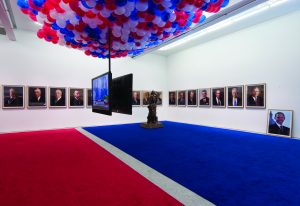
Jonathan Horowitz, Your Land/My Land (installation view), 2008. Courtesy the artist and Gavin Brown’s enterprise, New York. Photo: Thomas Müller
Jonathan Horowitz’s Your Land/My Land: Election ’12 (2012) depicts an epidemic that was and still is worryingly relevant in today’s society. His installation comments on the divide of a nation caused by political parties; he splits the space in half with blue on one side and red on the other thus manipulating the colours of the American flag. The colour divide not only addresses the clash between traditionalists and mavericks, but also refers to America’s cultural divide. This separation is further heightened by the back to back television monitor (located at the centre) which airs broadcasts of Fox News and CNN. Each monitor leans towards endorsing either the Democratic or Republican presidential candidates; whilst the audience observe a monitor, they are forced to face the people supporting the opposing candidate. This composition forces the audience to physically divide thus reflecting upon the dangerous and formidable face of the media’s propaganda. Ironically, the democracy of the nation that stands for freedom and equality is contorted into a form of tyranny that has fractured the nation. This face of politics (to different degrees) has survived since the dawn of civilisation and it continues to repeat itself; the fracture has only widened since the 2016 US election which deemed Donald Trump as the new president. Horowitz’s work is timeless as his art will continue to be relevant for years to come, as declared by Giorgio Agamben: “The contemporary is not only the one who, perceiving the darkness of the present, grasps a light that can never reach its destiny; he is also the one who, dividing and interpolating time, is capable of transforming it and putting it in relation with other times.”
Your Land/My Land: Election ’12, (2012) [Exhibition]. Houston, TX; Raleigh, NC; St Louis, MO; Los Angeles, CA; New York, NY; Salt Lake City, UT; Savannah, GA.
Agamben, G. (2007) What is the Contemporary? In: (2009) What is an Apparatus? and Other Essays. (trans.) D. Kishik & S. Pedatella. Stanford, California: Stanford University Press. pp. 39-54
Task 8
Silvia Pelissero, most commonly known as Agnes Cecile, creates polychromatic images that illustrate the human condition. Her portraits are not only aesthetically pleasing but are also profoundly expressive; the flow of the watercolours create movement thus animating the two-dimensional subjects. She shares an intimate and spiritual bond with her artwork; like most contemporary artists, she attempts to illustrate the ineffable through visual language. Within my appropriation of Agnes Cecile, I embraced the same element of organised chaos where the colours are spontaneous yet also structured. The vibrant acrylic colours of blue and red correlate with the subject’s inner subconscious; it physically expresses his inner turmoil as he is torn between emotions of rage and sadness. He is suspended at a state of pure confusion; despite him looking ahead beyond the page and yearning to move on, he is frozen in time. The dripping ink creates the impression of the subject melting and breaking his composure; he is vulnerable and malleable.
Task 10
A passionate expression of the human condition and its ineffability.
Within my practice, I typically gravitate towards portraiture that express a blend between realism and abstraction. I am not interested in painting the human visage in meticulous detail, I prefer to experiment with the colours of the skin, hair and eyes to convey a variety of emotions or thoughts that normally remains unsaid. My art is very personal, I share an intimate relationship with the work I produce, and they are not designed to be political but rather expressive. Within this piece, I have chosen to illustrate one of my greatest fears: the erosion of love and passion. In a world where divorce rates are rapidly increasing, and the traditional morals of faithful relationships are depleting, it is undeniably inevitable for most people to express anxiety and pessimism towards love. The two faces in the centre of the canvas are youthful and brimming with passion; they are layered with rich, warm colours of fiery red and orange which radiates optimism and spontaneity. However, as the viewer’s eyes drift further way from the centre, they are confronted with two ghostly faces that are gradually fading away. These grey, lifeless faces are antithetical to the other high-spirited faces; much like our youthful bodies, the vehement relationship that the couple once embraced has now withered and gone cold. Their love and passion are now just a distant lingering memory that they meander away from thus becoming hostile and desolate.
Task 1
Upon receiving the passport brief, I realised how strangely significant these legal documents are; they prove our identity and existence. One aspect of the passport that I was particularly interested in was its ability to let us travel. My jejune version of the passport lets me travel back to my childhood when I desired the simplest things. To create this childish mien, I used primary block colours for the cover which is coiled by a baby blue rubber band. The image that represents my fictional country depicts a golden owl which is inspired by my childhood obsession with birds. The concept of travel is reinforced by the banner below the bird which reads “Freedom”. The stamps inside the passport contain poorly drawn symbols of my interests which, despite growing older, hasn’t changed. Ideally, I would’ve liked to include more personal information about myself but couldn’t muster enough confidence.
Task 7
Leo Steinberg’s classic Other Criteria: Confrontations with Twentieth-Century Art (1972), discusses the sudden and unexpected shift in the way art was perceived and created during the 1950s. Influenced by the flatbed printing press, Steinberg correlates the pictorial surface of art with the “human posture”; he comments on the way cultural, social and political situations mould art. The changing mentalities forced a change in the way art is conceived; Steinberg explores the conception of the “picture as representing a world, some sort of worldspace”. Steinberg focuses on the works of Robert Rauschenberg and Dubuffet who have distanced from the previous “vertical fields” and transitioned into “opaque flatbed horizontals” thus altering the subject matter of art to emphasize culture over nature. This new orientation resulted in the modification of both the physicality and definition of art. Like Steinberg, Richard Serra (from the Yale lecture 1939) also comments on the changing orientation by referring to the way traditional means of creating sculptures have been replaced by new technology and industry. As a result, the concept of site-specificity has altered; “a new behavioural and perceptual orientation to a site demands a new critical adjustment to one’s experience of the place. Site-specific works primarily engender dialogue with the surroundings.” (pg. 23-33)
Charles Harrison, C, and Wood, P. (1999) Art in Theory, 1900-1990. An Anthology of Changing Ideas. Oxford: Blackwell
Task 6
Personally, my ideal studio would be a relatively large space consisting of four white walls. The blank walls create an empty space; a vacuum where I can think, focus and comprehend my ideas without distraction. Alone in my space, I am free to craft and create in various scales using a kaleidoscope of materials without limitation. Music is a major driving force in making my art hence I would colour the room with music. The music I listen to accompanies my thoughts and emotions; it immerses me into the world I create thus animating my paintings. This relaxed and therapeutic ambiance created is essential as it helps me slip into my subconscious where the minute problems of daily life no longer matter; instead I gravitate towards the wider subjects and emotions that I typically supress. This cubic white room is a space where I express myself without the worry of judgement.
Task 5
During the summer, I visited the exhibition ‘Beyond Caravaggio’ which was a collaboration between the National Gallery (London), the National Gallery of Ireland, and the National Galleries of Scotland. In this exhibition I found a multitude of enticing artworks, yet I was immediately engrossed in The Incredulity of Saint Thomas by Michelangelo Merisi da Caravaggio. His hyperrealist painting depicts Jesus proving his resurrection to Thomas the Apostle who previously disbelieved his miracle.
The experience of seeing this masterpiece in “the flesh” was startling; the lighting of the room was perfectly adjusted to illuminate the figures against the dark background. What I found particularly interesting was that Jesus (typically surrounded by a holy golden glow) is depicted to be a man of flesh and blood without the classic halo; the experience of seeing Jesus in this recognisable form makes the painting more immersive and real. The meticulous detail of the fabric, skin and hair renders me speechless, its astonishing how realistic it looks. There’s something oddly unsettling about the way Thomas’ finger penetrates Jesus’ flesh; the illusion of Jesus’ untouchable physicality is shattered.
Beyond Caravaggio (2016-2017) [Exhibition]. The National Gallery, London. 12 October 2016 to 15 January 2017.
Task 4
Saatchi Gallery and Huawei’s collaborative exhibition Selfie to self-expression (31st March – 28th May 2017) displayed a kaleidoscope of innovative and experimental photographs; it is also the first exhibition in the world to focus on the development of selfies throughout history. The works accumulated were taken from the competition #SaatchiSelfie which offered the opportunity for artists from all over the world to express themselves in the form of selfies. Most artists used this exhibition as a means of addressing our obsession with social media as selfies have quickly become a common tool of socialisation.
Artists explore our unhealthy idealization of perfection as well as the modern disillusionment with reality thus creating works that are beautiful yet perilous. For instance, Ola Walków’s graphic and invasive collection „My only dream was about being beautiful, but it was hurting me…. I had to do it…..” illustrates the struggle of body acceptance; Walków’s selfie causes great unease as it forces the viewers to experience her sensations during the surgery. Other artists like Finnian Croy’s Duo transports us into the familiar setting of the bathroom. This mundane setting is interrupted by the double reflection of the subject, thus adding a layer of discomfort; like Walków’s piece, we are no longer a silent observer as the subject is aware of our presence. Most contemporary selfies tend to focus on existentialism and ultimately questions our way of thought, understanding and purpose.
Selfie to self-expression, (2017) [Exhibition]. Saatchi Gallery, London. 31st March – 28th May 2017.

